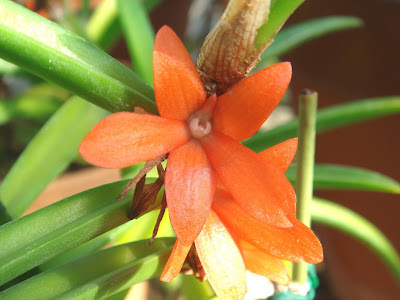Ceratostylis retisquama is native to the Philippines. Its natural habitat is trees in areas exposed to the sun at an altitude of 0-500 meters...
Ceratostylis retisquama also called as Ceratostylis latipetala, Ceratostylis rubra, is a species of the genus Ceratostylis. This species was described by Heinrich Gustav Reichenbach in 1857.
IDENTIFY CERATOSTYLIS RETISQUAMA
Ceratostylis retisquama is native to the Philippines. Its natural habitat is trees in areas exposed to the sun at an altitude of 0-500 meters.
It is a small sized, warm to hot growing epiphytic plant terete pseudobulb and tough, linear-falcate, up to 14 cm long leaf, and grows into dense mats.
Ceratostylis rubra flowers from the dry, brown sheaths at the base of the pseudobulb, in almost all seasons with a solitary or pair of, short-lived flowers arising on a short stalk on a new growth at the base. The orange flowers are up to 3 cm in diameter. The flowers are not long-lived and last only 7-12 days.
CERATOSTYLIS RETISQUAMA CARE AND CULTURE
Cultural information should only be used as a guide, and should be to be adapted to suit you. Your physical location; where you grow your plants, how much time you have to devote to their care, and many other factors, will need to be taken into account. Only then can you decide on the cultural methods that best suit you and your plants.
Light:
Ceratostylis retisquama needs a light level of 35000-38000 lux. The direct morning sun is well liked, but during lunch hours it must be lightly shielded. The photoperiod is 12-14 hours.
Temperature:
The ideal temperatures is 24-26 ° C during the day and 19-20 ° C at night in summer and 22-24 ° C during the day and 18-19 ° C at night in winter.
Humidity:
If Ceratostylis rubra is placed in a vase, 55-60% are enough. If these are bare-root specimens, the minimum required is 65%.
Substrate, growing media and repotting:
The best results with Ceratostylis retisquama are obtained if it is grown bare root inside an orchid. Do not put sphagnum on the raft, because the roots, being sensitive to excess water, must dry quickly. If the specimen is kept on a window sill, that is, in the typical conditions of the house, a thin layer is spotted serves, because it guarantees a reserve of moisture. It is also possible to grow this species in a vase, choosing a wide basket (to accommodate its growth mode) as a vase and the substrate composed of medium-large pine bark (3-5 cm). Sphagnum is not added in this case.
Watering:
This species gets water regularly throughout the year. The watering occurs when the substrate has dried completely, but care should be taken not to leave the plant dry for more than a day. The bare root specimens get water daily, on the hottest days the orchid may need two watering. Keep in mind, however, that the roots must dry out before the evening's arrival. It is also important to avoid stagnation of water in the axils of the leaves.
Fertilizer:
This orchid is fertilized every 3 waterings (but no more often than once a week), using 1/2 of the dose indicated on the vial of a special liquid fertilizer for orchids. For bare root orchids, 1/8 of the watering water dose is added once a week. Before fertilizing the plant it is necessary to water it to avoid the harmful contact of the fertilizer with the dry roots.
Rest period:
Ceratostylis retisquama does not need a rest period. Such conditions should be maintained throughout the year. The plant can bloom in any season.















COMMENTS